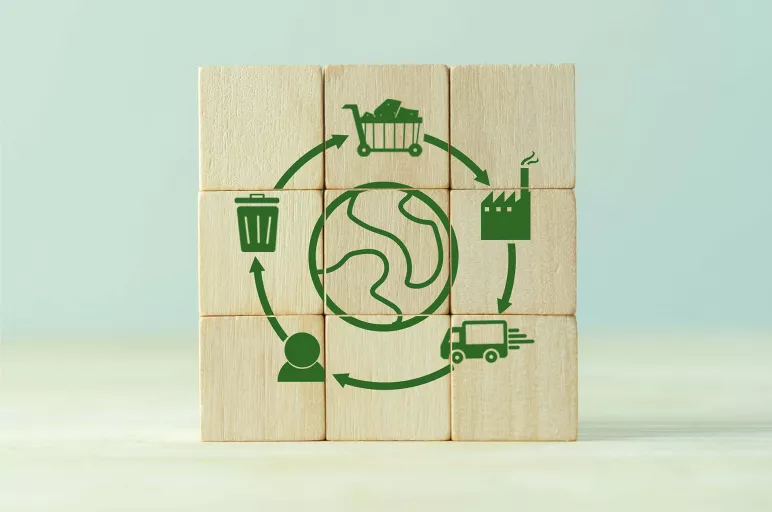
A Short Guide to Circular Supply Chains
- The circular economy minimizes the use of resources, reduces waste and decreases pollution and carbon emissions.
- Industries are increasingly incorporating circular economy principles into their supply chains to promote sustainable practices.
- In circular supply chains, firms can manage their budgets efficiently and keep costs under check by tracking of the amount of recycled material that can be repurposed in manufacturing of new products.
February 02, 2023 | Supply Chain Strategy 4 minutes read
The global economy has traditionally been based on the principle of the linear economy — produce, use, and discard. This mode of operation generates an enormous amount of waste and is unsustainable in the long run.
To become more sustainable, industries across the globe are adopting practices that support a circular economy. Businesses are now investing in sustainability initiatives that aim to reduce waste and minimize carbon emissions.
A circular economy is based on the principle of — reducing, reusing, and recycling. The circular economy also encourages repair, sharing, refurbishing, and re-manufacturing. Compared to the linear approach, this operation mode generates less waste and supports the optimal use of resources.
The circular economy minimizes the use of resources, reduces waste, and decreases pollution, and carbon emissions. It aims to stretch the use of products and equipment, over extended periods to enable the most optimal use of valuable resources.
Increasingly, industries are incorporating circular economy principles into their supply chains to promote sustainable practices. The circular economy supports sustainability initiatives that promote energy efficiency, focus on sustainable product packaging , stress on the use of alternative fuels and optimized shipping routes and push for responsible returns management.
Consumer packaged goods companies, for example, are now committed to making all of their packaging from recyclable or reusable materials.
Importance of Circular Supply Chains
In the circular supply chain, all the raw materials are recycled and used again in manufacturing. This way, the raw material is repurposed in the production process and used to manufacture a different product. Such reuse and repurposing of the material eliminates waste and reduces the carbon footprint.
The initiative to support the circular economy by reusing, refurbishing, repurposing and recycling material enables the building of a sustainable supply chain.
Lately, green operations have become a priority for nearly every industry.
Considering that the amount of waste generated is increasing every year, it is now imperative, for the industry and the consumers to choose products that have the smallest possible environmental footprint.
Consumers, increasingly, are conscious of their purchasing decisions, and according to a Nielsen report, a majority (66%) of them are even willing to pay a premium for sustainable products.
Therefore, companies must also become conscious of the environmental impact of their operations and should be aligned with the sensibilities of their environmentally conscious customers.
In any business, the prices of raw materials affect the total cost of goods manufactured and, by extension, on company budgets. Businesses perpetually find it challenging to manage their budgets, especially with the prices of raw materials experiencing volatility. In circular supply chains, firms can manage their budgets efficiently and keep costs under check by keeping track of the amount of recycled material that can be repurposed in the manufacturing of new products.
More and more governments are now making policies that expect businesses to implement circular supply chain management requiring the recycling of material and efficient waste disposal practices. Governments are also incentivizing ‘green’ initiatives by firms to reduce the environmental impacts of their production and distribution activities.
Difference between Linear and Circular Supply Chains
A linear supply chain is a straight route -- from raw materials to manufacturing to disposal. In the linear supply chain, the product is discarded by the consumer at some point. This makes the supply chain inefficient. When a new product is manufactured, the old one is disposed in a landfill. Even the left over raw material is disposed as waste in landfills.
On the other hand, in a circular supply chain, all the raw materials used are recycled and reused in the manufacturing process. Here, the raw materials are repurposed and used to manufacture another product. By reusing and repurposing material, circular supply chains help eliminate waste and minimize the carbon footprint of the manufacturing and consumption process.
By recycling used material, circular supply chains promote recycling at scale enabling the most optimal use of materials, helping build a sustainable supply chain , and saving costs for the business.
Conclusion
Globally, businesses and governments are now working in concert to drive the adoption of practices for sustainable manufacturing , consumption, and disposal of products. In this direction, businesses are implementing circular supply chain practices, reusing and repurposing products after they have reached their end life instead of disposing them in landfills.
Consumers too are participating in this effort by actively supporting sustainability by choosing products manufactured by businesses that follow green production processes. The government, on its part, together with making laws that mandate the adoption of green practices, is also incentivizing their greater adoption.



